Please scroll down for English
Francesca Woodman • Zigzag
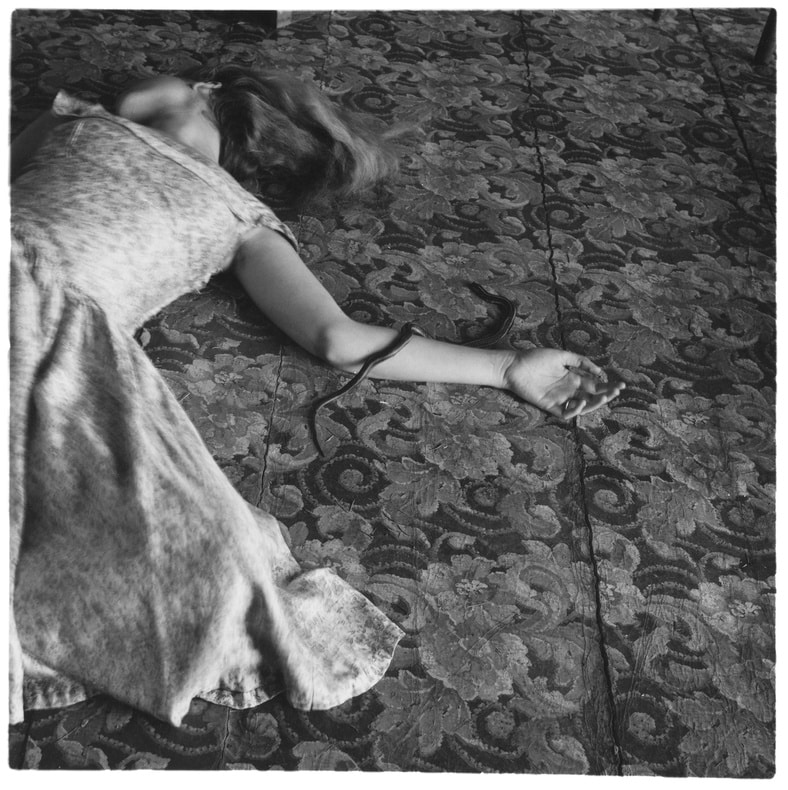
המפגש עם גוף עבודה מוגדר, שלם וסופי של אמנים שנפטרו או התאבדו בגיל צעיר מאד מספק הזדמנות למבט מרוכז במסלול קצר מאד בו התחלה אמצע וסוף הופכים כמעט לאחד. בתערוכה Zigzag של פרנצסקה וודמןFrancesca Woodman, צלמת אמריקאית שהתאבדה 1981 בגיל 22 התחושה הזו חריפה במיוחד. וודמן הותירה גוף של כ 800 עבודות שנעשו מאז הייתה בת 13. היא גדלה בסביבה עתירת אמנות עם שני ההורים אמנים ומרצים לאמנות ובילתה חלק ניכר מילדותה איתם באיטליה. כאמנית צעירה זכתה בהכרה, כולל בפרס שהיה של שנה ברומא. ההכרה בעבודתה גברה אחר מותה ובאה לביטוי בשורת תערוכות יחיד בחללים כמו Fondation Cartier בפריז ו The Photographers’ Gallery בלונדון. ב 2011 הוצגה עבודתה במוזיאון לאמנות מודרנית בסן פרנסיסקו ובגוגנהיים בניו יורק. עבורי היה זה מפגש ראשון עם העבודות.
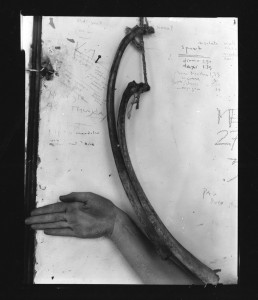
1975-1978
בחלל של גלריה ויקטוריה מירו בלונדון (ב Mayfair) מוצגים דימויים קטנים בשחור לבן ושני דימויים גדולים בספיה, בסך הכל עשרים וחמישה צילומים שמשאירים את הצופים בין מועקה לסקרנות גדולה. בצילומים בולט חוסר שקט, חוסר איזון ודחיפות. בעבודות הספיה הגדולות התחושה היא של חקירה, גישוש שאינו מעמעם יד מקצועית בוטחת.
הנושאים כמעט בנאליים: הרבה צילומי שכוללים קטעי גוף נשי, אובייקטים (טבע דומם), מעט צילומים של נוף. אפשר לחוש באפיונים של תקופה, אסטטיקה של שנות ה70 אבל החריפות, היופי הגדול של העבודות הופך את העניין בהן להרבה יותר מהיסטורי.קו שבור , זיג זג, הוא חוט השני המקשר את העבודות. זו צורה שאינה נוחה כמו המלבן והריבוע הקלאסים. בקומפוזיציות של וודמן נדמה שתמצתה למינימום הכרחי את מה שחייב להיות בכל פריים ופריים.

היא מצולמת במרבית הצילומים ובכל זאת הם אינם דיוקנאות עצמיים. השימוש בעירום שלה עצמה נעשה במסורת המובהקת של צילום גברי. היבט זה בעיתי -מהלך הזמן משנות ה80 ועד היום לימד שאימוץ אסטרטגיות שליטה כמו גבריות על ידי נשים (כך למשל נשים תומכות בפורנוגרפיה) לא הוביל למקומות טובים יותר. החיפצון נותר חיפצון גם עם הוא נעשה על ידי אישה.
עבודה בה אשה בשמלה מבד ברוקד שרועה על שטיח פרחוני ונחש על זרועה נחרט בזיכרון. עם הבגדים שנראים מ”מד מן” והנחש מסיפור פיתוי חווה מתנסח הרהור מלא על נשיות, תאווה ומשאלת מוות. יד שמצולמת ליד פיסות עץ מעוגלות, וילון עם נוצות,קווי אור שבורים ויד האמנית מרגשים ממש. עבודות הספיה גדולות, בנויות כדיפטיך שהוא חלונות קונטאקט של סרט צילום מרמזות על כיוונים שלא פותחו, של עושר שמופיע כבר בצילום האישה על השטיח.
Victoria Miro Mayfair • 14 St George Street, London W1S 1FE
Closing 4 October 2014
אורית ישי – נוֹרָא יָפֶה | יעל בלבן – יָפֶה נוֹרָא
שתי תערוכות היחיד, של אורית ישי ויעל בלבן נסבות סביב מקום בו יופי ואימה משיקים. הן נוגעות בדימוי מובהק בו האפל מובלע ביפה, בדימוי זרי פרחים ומוטיב המעגל-הזר.
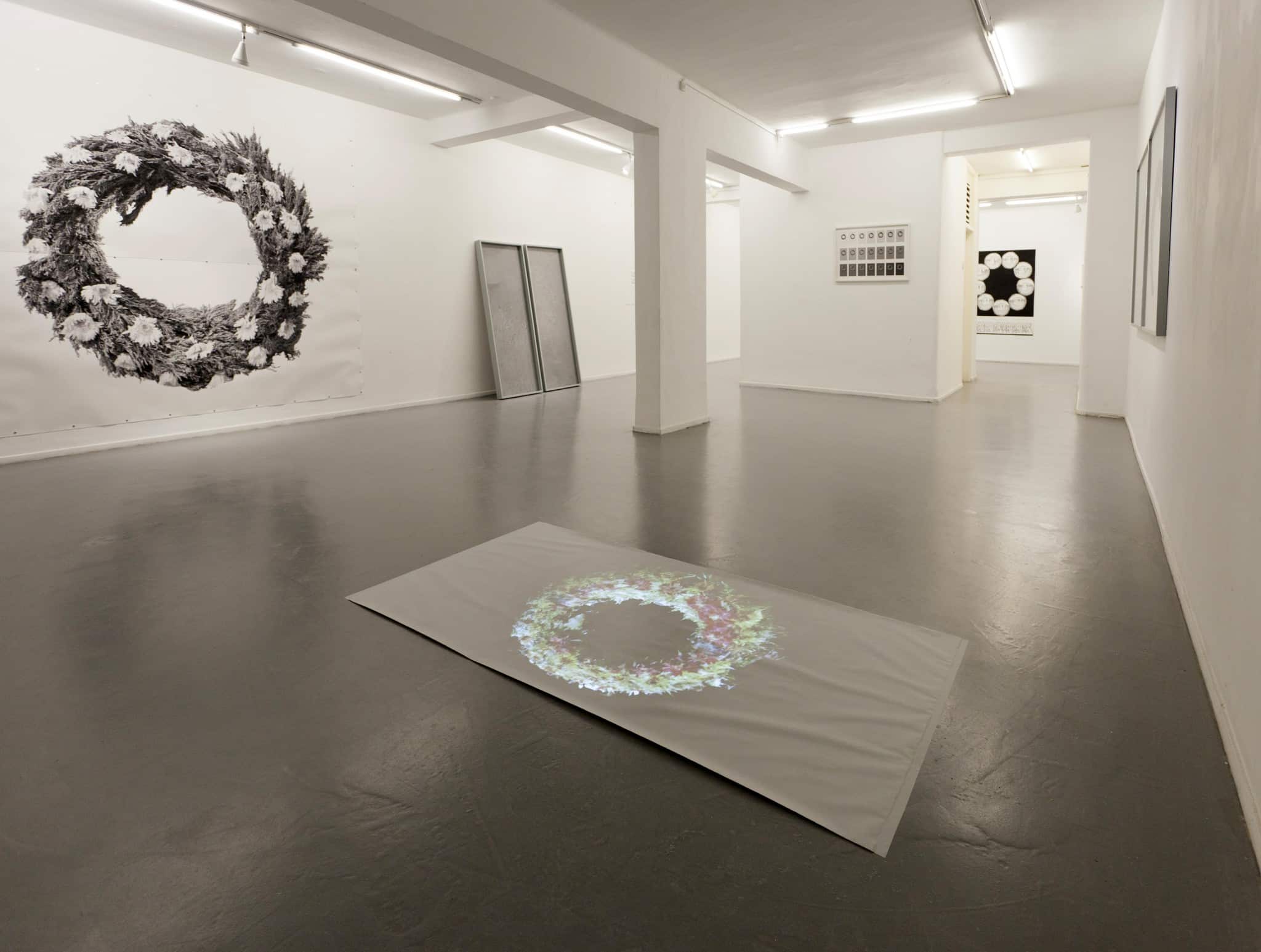
התקדימי בתולדות האמנות הם כבר מהעת העתיקה דרך הרנסנס האיטלקי ורנסנס הצפוני. אינספור זרי הפרחים והמוות בציורי טבע דומם ובמיוחד ואניטס מתקשרים ישירות לזרים המוצגים. באמנות עכשווית יש גם כן דוגמאות רבות כמו הפרחים הנובלים של אניה גאלצ’יו הבריטית , והתקדימים הישראלים ביניהם שוש קורמוש, משה גרשוני, ארז ישראלי ועדי ברנדה.
מטען האסוציאציות מעשיר, מוסיף שכבות של אירוניה.יעל בלבן רשמה ברפידוגרף זרים מורכבים מגברים ונשים במה שיכול להעלות על הדעת סצנות זוועה אך גם מחול.

ב “תשע עדשות” הזר הוא מה כחיבור מבטים מבעד לעדשה. בכל עיגול יש מעקב אחר סצנה של ילד עם מבוגרים ליד בקתה והתחושה היא כשל מבט מבעד לכוונת כך שהצופים הופכים שותפים למעשה שצפונה בו אלימות.זרי אבלות הם הדימוי החוזר בעבודות של אורית ישי, זרים שהמציאות הישראלית הופכת שוב ושוב למוטיב חוזר בתיעוד החיים הלאומיים. ברבות מהעבודות ישי ממירה את הצבעוניות לסקלת הצבעים שבין שחור ולבן. מרשים במיוחד הוא “בצילום כמו בצילום, האפור הוא אפור” (2014) הינה הדפס זר שהוגדל עד שהדימוי מתחיל להתפרק לפיקסלים כמו הקלישאות המתלוות לזרים באשר לזיכרון הנצח הניתן לנופלים.נצח הזיכרון מתפרק והנופלים, אחרי חייהם בלב יקיריהם, נשכחים כמו כל הנופלים שקדמו להם. ישי נוגעת בפריכות של מונחי זמן גם בעבודה שהיא צילום של הצטברות אבק על לוח מחוץ לסטודיו.

(still from video)
עבודת הוידיאו “מונחים” מתייחסת בשמה לסדרה של שוש קורמוש. היא מורכבת מצילומי סטילס של זרי אבלות שעולים-מתמזגים זה על זה, מתמוססים ליצירת זר חדש והסרטים השחורים שעליהם מתאחדים.העבודה מוקרנת בלופ, יופי ואבל אינסופי, עמוק וחסר טעם באותה עת.
זו תערוכה יפה שאיאפשר שלא לקרוא בצל הקיץ האחרון.
אוצרת: יעל קיני
גלריה הקיבוץ דב הוז 25, תל-אביב
הרשמה לניוזלטר הפירסומי השבועי של “החלון” בנושאי אמנות, אירועים ותערוכות חדשות – www.smadarsheffi.com/?p=925 (הרישום נפרד מהרישום לבלוג )
הערות/הארות אנא כיתבו ל thewindowartsite@gmail.com
Francesca Woodman • Zigzag
The encounter with a defined, complete and finite oeuvre of an artist who passed away or committed suicide at a very young age provides the opportunity for a quintessential look at a very short trajectory in which beginning, mid- and end-career become almost one.

This sensation is especially acute when viewing the exhibition Zigzag by the late American photographer Francesca Woodman (who committed suicide in 1981 at the age of 22). Woodman left a body of work of 800 photographs made since she was 13. Raised by parents who were both active artists and lecturers on art, Woodman spent a great deal of her childhood in Italy. Recognition came at an early age, and she was awarded a one-year art residency in Rome. Woodman had many posthumous shows of her work, such as at Fondation Cartier, Paris; the Photographers’ Gallery, London; the San Francisco Museum of Modern Art and the Guggenheim in New York City in 2011. This was my first encounter with Woodman’s artworks.
The Victoria Miro Gallery space in Mayfair hosted 23 small black and white photographs and two large sepia
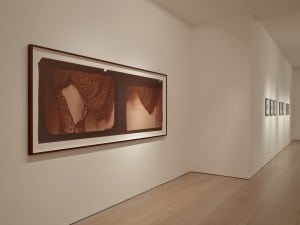
photographs, leaving viewers caught between distress and intrigue. A lack of tranquility pervades all of the photographs, with imbalance and urgency. In the large sepia works the feeling is one of exploration, with a sure professional touch. The subjects are almost banal: female nudes, still life, and landscape. The aesthetics of the 1970s are visible, but the keenness and great beauty of the works make them much more than of mere historical interest.
A broken zigzag line is the theme linking the compositions. It is an uncomfortable form, unlike the classical rectangle and square. Woodman seems to have placed the essence of the absolute minimum necessary in each frame.
She appears in nearly all of the photographs, yet they are not self-portraits. The nude female body as a repeated image follows the tradition of photographs by male artists. This does not make it feminist. Since the ‘80s, we have learned that females adopting male strategies (such as women supporting pornography) have not improved matters. Extroversion remains extroversion even when exhibited by a woman.

The photograph in which a woman in a brocade dress sprawls on a flowery carpet with a snake on her arm is excellent. The clothing could be taken from “Mad Men,” and the snake is right out of the Garden of Eden; together they formulate a meditation on femininity, desire and a death wish. A hand photographed near a curved piece of wood, a feathery curtain with broken lines of light and the artist’s hand are truly moving images. The large sepia photographs forming a diptych of contact sheets hint at undeveloped directions, of the richness which may already be seen in the photograph of the woman on the carpet.
Victoria Miro Mayfair • 14 St George Street, London W1S 1FE
Closing 4 October 2014
Orit Ishay: Terribly Pretty | Yael Balaban: Awfully Beautiful
Two one-person exhibitions by Orit Ishay and Yael Balaban, both address beauty and terror. Their interface makes them darker and more compelling, as both use the motif of the circular wreath.Precedents in art history from ancient times through the Italian and Northern Renaissance paintings, feature innumerable wreaths of flowers, in memento mori paintings and especially “Vanitas” paintings. Direct associations may be to wreaths by contemporary artists such as British artist Anya Gallaccio to Israelis such as Shosh Kormosh, Moshe Gershuni, Erez Israeli and Adi Brande.


These associations enrich and add a layer of irony to the works.
Yael Balaban uses a Rapidograph to make ink drawings of wreaths composed of men and women in scenes of horror or dance. In Nine Lenses, the various gazes through a lens form a wreath shape. Each circle tracks a scene of a boy with adults near a hut, as if seen through the sights of a gun, making viewers part of the potential violence.
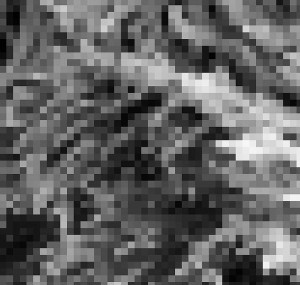
Orit Ishay uses imagery of funeral wreaths, which frequently appear in documentation of current life in Israel, especially soldiers’ funerals. Ishay’s treats the photographs to leach out the color and use a black to white scale. Her piece, “In photography as in the photograph, gray is gray” (2014), is especially impressive. It is a print of an enlarged wreath on a scale so big that the image breaks down into pixels, like the clichés of eternal remembrance accompanying wreaths. The eternity of memory breaks down as the fallen are forgotten when their loved ones pass away along with the memories, just as in previous generations. Ishay’s photograph of accumulated dust evokes the fragility of concepts referring to time.

(still from video)
The title of the video Terms refers to Shosh Kormosh’s series of stills of the same name. Ishay’s video is composed of stills of funeral wreaths overlapping each other, melding into a new wreath, with their black ribbons coming together. The work is screened in a loop of beauty and infinite mourning, simultaneously contemplative and pointless.
This beautiful exhibition cannot escape being read in the shadow of the events of this past summer.
Curator: Yael Kainy
The Kibbutz Gallery, 25 Dov Hoz, Tel Aviv
Join the mailing list for Window’s weekly informational advertising newsletter: www.smadarsheffi.com/?p=925
Comments – please write to thewindowartsite@gmail.com






